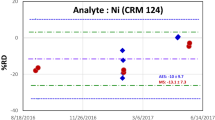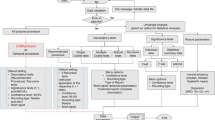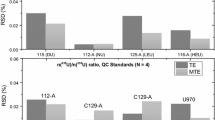Abstract
Measurement uncertainty (MU) associated with the determination of the light rare earth elements (La, Ce, Pr, Nd, Sm, Eu), yttrium and uranium in different types of rock samples by an ICP-OES method has been evaluated by the three principal approaches: the GUM modelling approach, the Nordtest single laboratory approach and the Horwitz equation. A within-laboratory validation data for specificity, linearity, range, accuracy and precision was used for the MU calculations. Procedures have been described for the MU calculations by the three approaches and MU results for an in-house rock sample by the three approaches have been compared. MU results by the GUM approach were in good agreement with those obtained using the Horwitz equation, but were lower than those obtained by the Nordtest approach.
Similar content being viewed by others
References
ISO/IEC 17025:2017 General requirements for the competence of testing and calibration laboratories. ISO, Geneva
ISO/IEC Guide 98-3 Uncertainty of measurement—part 3: guide to the expression of uncertainty in measurement (GUM: 1995). ISO, Geneva
JCGM 104:2009 Evaluation of measurement data—an introduction to the “Guide to the expression of uncertainty in measurement” and related documents
Magnusson B, Naykki T, Hovind H, Krysell M (2003) Nordtest report TR 537: handbook for calculation of the measurement uncertainty in environmental laboratories
EUROLAB Technical Report 1/2007 Measurement uncertainty revisited: alternative approaches to uncertainty evaluation
Horwitz W, Albert RJ (2006) The Horwitz ratio (HorRat): a useful index of method performance with respect to precision. J AOAC Int 89(4):1095–1109
Thompson M (2007) Limitations of the application of the Horwitz equation: a rebuttal. Trends Anal Chem 26:659–661
Mermet JM (2005) Is it still possible, necessary and beneficial to perform research in ICP-atomic emission spectrometry. J Anal Atom Spectrom 20:11–16
Satyanarayana K, Girija S, Malhotra RK, Tickoo BN (1989) Determination of rare earth elements and yttrium in some uranium and thorium rich geological materials by inductively coupled plasma emission spectrometry. Expl Res At Min 2:235–245
Lalithambal R, Bhargava PK, Chowdary GS, Kumar Adarsh (2007) Determination of uranium by inductively coupled plasma optical emission spectrometry. Expl Res At Min 17:21–24
Kumar Adarsh, Beena S, Lalithambal R, Chowdary GS (2007) Determination of rare earth elements and yttrium in rock samples by ICP-OES. Expl Res At Min 17:70–75
Kumar Manjeet (1994) Recent trends in chromatographic procedures for separation and determination of rare earth elements—a review. Analyst 119:2013–2024
Srivastava PK, Premadas A (1999) Determination of rare earth elements and yttrium in rocks by inductively coupled plasma atomic emission spectrometry after solvent extraction with a mixture of 2-ethylhexyl dihydrogen phosphate and bis (2-ethylhexyl) hydrogen phosphate. J Anal At Spectrom 14:1087–1091
Murty DSR, Mahanta PL, Radhamani R (2002) Determination of rare earth elements in different geological matrices by ICP-AES after solid phase micro extraction on activated charcoal. At Spectrosc 23:65–74
Khorge CR, Chakraborty P, Saran R (2000) Determination of rare earth elements in iron rich geological samples by ICP-OES. At Spectrosc 21:220–224
Magnusson B, Ornemark U (2014) Eurachem guide: the fitness for purpose of analytical methods—a laboratory guide to method validation and related topics, 2nd edn. ISBN 978-91-87461-59-0. https://www.eurachem.org
Thompson M, Ellison SL, Wood R (2002) Harmonized guidelines for single-laboratory validation of methods of analysis (IUPAC Technical Report). Pure Appl Chem 74(5):835–855
Acknowledgements
The authors thank the Director, Atomic Minerals Directorate for Exploration and Research (AMD), Hyderabad, India for the kind permission to publish this work and the Additional Director (R & D), AMD for the support. The authors also thank the different uranium exploration groups of AMD for providing the samples.
Author information
Authors and Affiliations
Corresponding author
Additional information
Publisher's Note
Springer Nature remains neutral with regard to jurisdictional claims in published maps and institutional affiliations.
Electronic supplementary material
Below is the link to the electronic supplementary material.
Rights and permissions
About this article
Cite this article
Padmasubashini, V., Sunilkumar, B., Krishnakumar, M. et al. A comparative study of the principal approaches for the estimation of measurement uncertainty for the ICP-OES determination of the light rare earth elements, yttrium and uranium in rock samples. J Radioanal Nucl Chem 325, 229–236 (2020). https://doi.org/10.1007/s10967-020-07214-5
Received:
Published:
Issue Date:
DOI: https://doi.org/10.1007/s10967-020-07214-5




